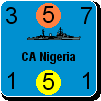ORIGINAL: Froonp
ORIGINAL: Shannon V. OKeets
When playing with carrier planes, every carrier needs a carrier air unit in order to do anything at all. So, using standard WIF FE rules, you would pay for the carrier and the carrier air unit. As MWIF is coded right now, playing without the 'optional' rule for carrier planes, a player gets all the benefits of carriers at a reduced cost. The bias is towards major powers that have carriers: especially CW in the beginning of the war and the US once it enters the war.
Making carriers cost more when not playing with carrier air units, brings the cost of carriers back into balance with the other cost of units being produced.
To give more food for thought, let's also consider that CVP cost 3 BP when playing without the "Pilots" option.
If playing with the "Pilots" option, then the CVP cost 0 to 2 BP (well 99% cost 1 BP), and you need to build a pilot (crew) to man the CVP. The food for thought is that the pilot is not always destroyed when the CVP is lost. It is only destroyed about half of the time when fighting and destroyed above the sea with friendly ships or ports in that sea area, and destroyed 100% of the time by AA.
To take this thought a bit further:
Not using CVPs makes X in the Air Combat damage the CV. With the suggested BP modification the cost of an X in a Air combat is then 2 BP for a CVL or 3 BP for a CV. Which is fine if the pilot option is not used, but if the pilot option is used, the pilot would often survive and the CVP cost is less than that. On the oposite side though: it takes just 2 turns to repair a damaged ship while 4 to build a CVP and that is a benefit. (Conclusion: with pilots: CV costs a litle more but halves the production time)
Then another factor emerges:
Take an average naval combat: a American and British task force in MED against a Italian and German LBA. In the Air Combat each side gets a DX result so an German FTR is shot down and a CW CV is damaged. The Axis get 5 Air To Sea Factors cleared (after AA), spend suprise points for 2 column shifts and there are 11 ships, giving the Axis a 1X, 2D and 2A result against the Allied task force. The X takes the CV, but the Axis get to choose the second D too, and this goes to the CV that was damaged in the Air combat, so the allies looses 2 CV instead of just 1 and another one damaged.
The lesson here is that without CVP it's easier to sink CVs. That happens whenever you get an naval air combat with DX/AX in an air combat and your opponent gets to choose a D in the naval combat. And whenever that happens you pay the full CV cost (which would be typical 8 BP for Essex class CVs) instead of CV repair and building a new CVP (which is 2+1 BP). But most signifcantly: Building a CV takes long time (10 turns for Essex class), so would you really do this? Wouldn't the CV be gone for the remainder of the game?
Then yet another factor emerges:
In a surface naval combat or a sub naval combat where a CV is targeted (by expending suprice points), the cost of a D to a CV is 3 BP without CVP rule but 2 BP with CVPs since the CVP and pilot is not affected by the D on the CV. (The cost of a X is not changed because an X would kill both the CV and the CVP with pilot.)
Conclusion
I made the arguments assuming the cost of CVs was increased as per Patrice's suggestion. This makes initial CV building
almost as expensive as with CVPs. (I say
almost because of the wrong CVP for CV problem that makes you produce more CVP than you need.) But at the same time the cost of using the CVs in naval-air combats increases dramaticly. The cost of using the CVs in other naval combats inreases a litle. The cost of using CV on other missions (port strikes, ground strike, etc..) is as before.
And what advice should I give now? [&:]







